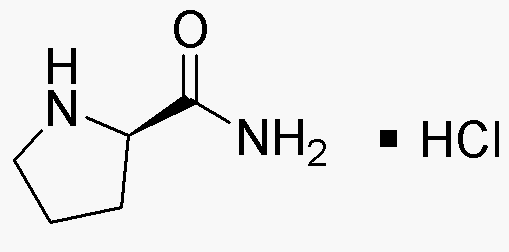D-Proline amide hydrochloride is widely utilized in research focused on:
- Pharmaceutical Development: This compound serves as a building block in the synthesis of various pharmaceuticals, particularly in the development of drugs targeting neurological disorders.
- Peptide Synthesis: It is commonly used in the synthesis of peptides, enhancing the stability and bioactivity of peptide-based therapeutics.
- Biochemical Research: Researchers use it to study protein folding and stability, providing insights into diseases related to misfolded proteins.
- Cosmetic Formulations: The compound is incorporated into skincare products for its moisturizing properties, improving skin texture and hydration.
- Food Industry: It is utilized as a flavor enhancer and stabilizer in various food products, contributing to improved taste and shelf life.
General Information
Properties
Safety and Regulations
Applications
D-Proline amide hydrochloride is widely utilized in research focused on:
- Pharmaceutical Development: This compound serves as a building block in the synthesis of various pharmaceuticals, particularly in the development of drugs targeting neurological disorders.
- Peptide Synthesis: It is commonly used in the synthesis of peptides, enhancing the stability and bioactivity of peptide-based therapeutics.
- Biochemical Research: Researchers use it to study protein folding and stability, providing insights into diseases related to misfolded proteins.
- Cosmetic Formulations: The compound is incorporated into skincare products for its moisturizing properties, improving skin texture and hydration.
- Food Industry: It is utilized as a flavor enhancer and stabilizer in various food products, contributing to improved taste and shelf life.
Documents
Safety Data Sheets (SDS)
The SDS provides comprehensive safety information on handling, storage, and disposal of the product.
Product Specification (PS)
The PS provides a comprehensive breakdown of the product’s properties, including chemical composition, physical state, purity, and storage requirements. It also details acceptable quality ranges and the product's intended applications.
Certificates of Analysis (COA)
Search for Certificates of Analysis (COA) by entering the products Lot Number. Lot and Batch Numbers can be found on a product’s label following the words ‘Lot’ or ‘Batch’.
*Catalog Number
*Lot Number
Certificates Of Origin (COO)
This COO confirms the country where the product was manufactured, and also details the materials and components used in it and whether it is derived from natural, synthetic, or other specific sources. This certificate may be required for customs, trade, and regulatory compliance.
*Catalog Number
*Lot Number
Safety Data Sheets (SDS)
The SDS provides comprehensive safety information on handling, storage, and disposal of the product.
DownloadProduct Specification (PS)
The PS provides a comprehensive breakdown of the product’s properties, including chemical composition, physical state, purity, and storage requirements. It also details acceptable quality ranges and the product's intended applications.
DownloadCertificates of Analysis (COA)
Search for Certificates of Analysis (COA) by entering the products Lot Number. Lot and Batch Numbers can be found on a product’s label following the words ‘Lot’ or ‘Batch’.
*Catalog Number
*Lot Number
Certificates Of Origin (COO)
This COO confirms the country where the product was manufactured, and also details the materials and components used in it and whether it is derived from natural, synthetic, or other specific sources. This certificate may be required for customs, trade, and regulatory compliance.


